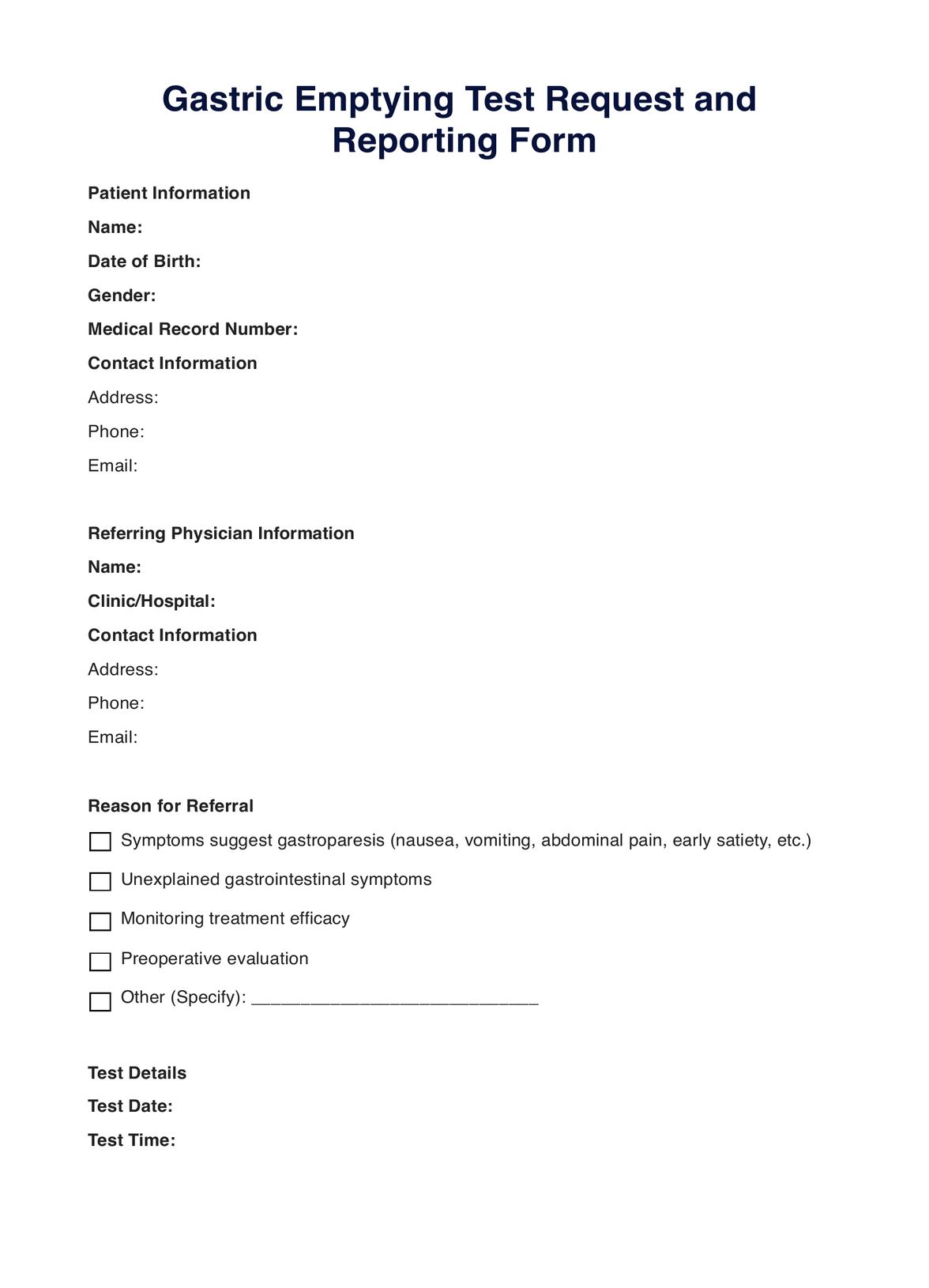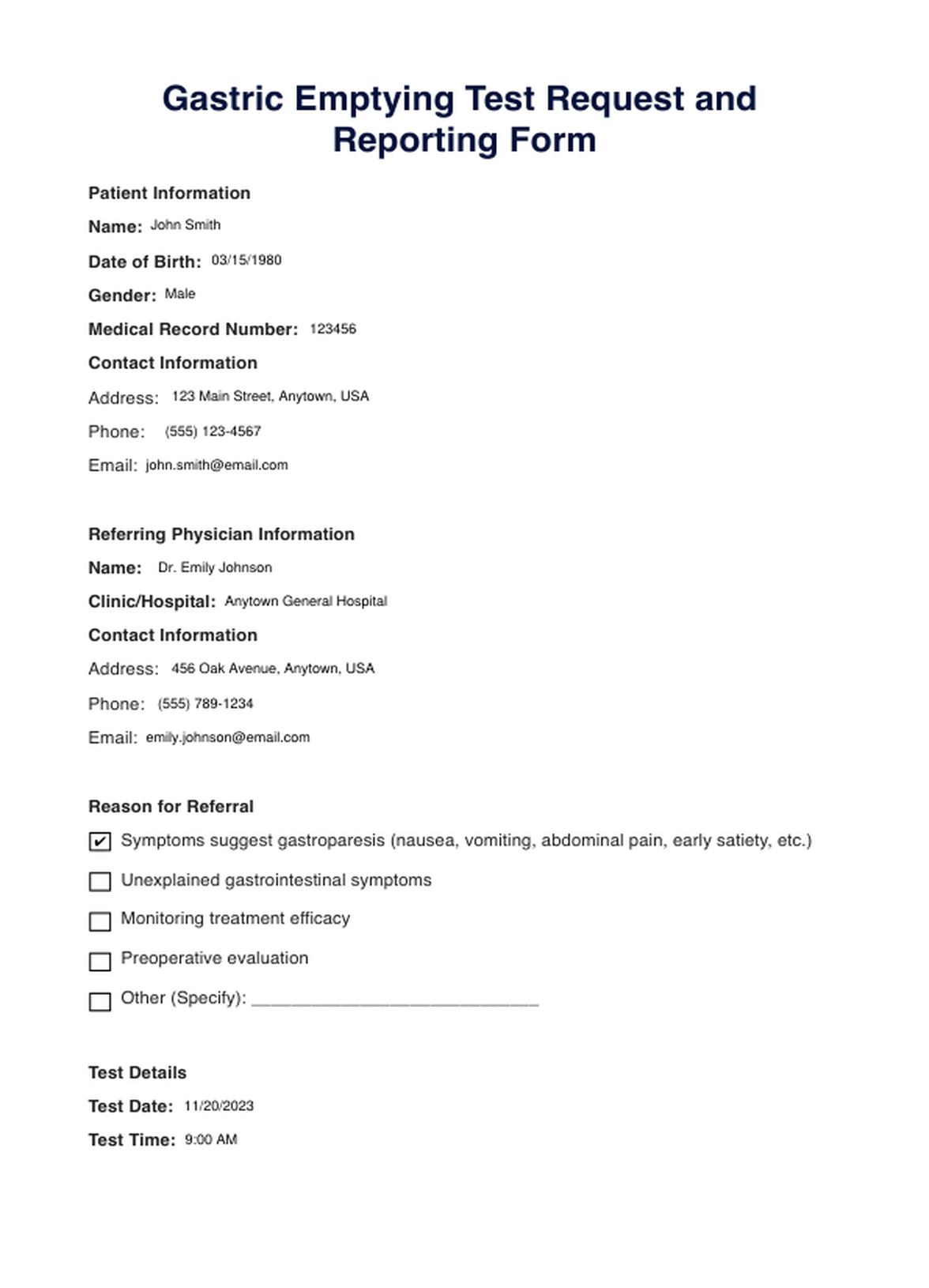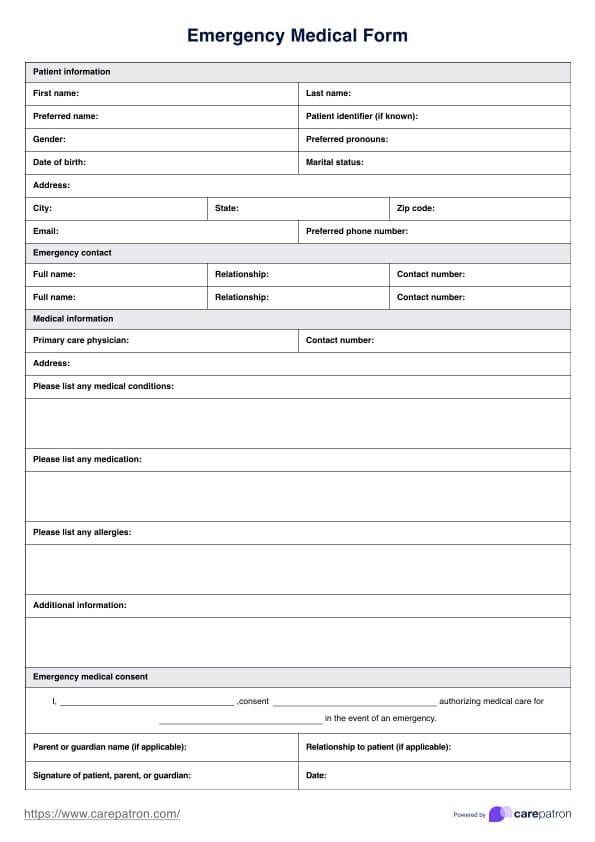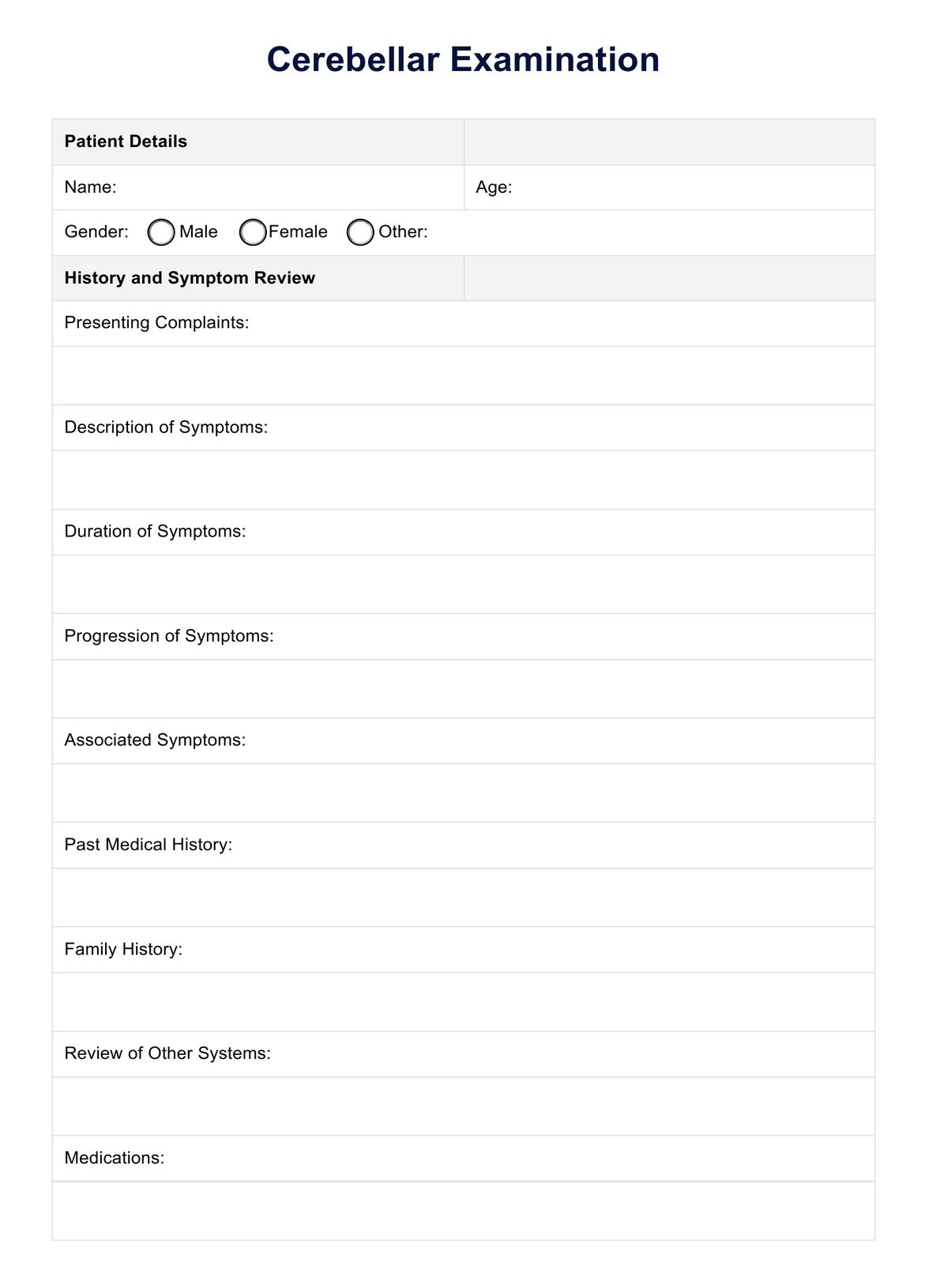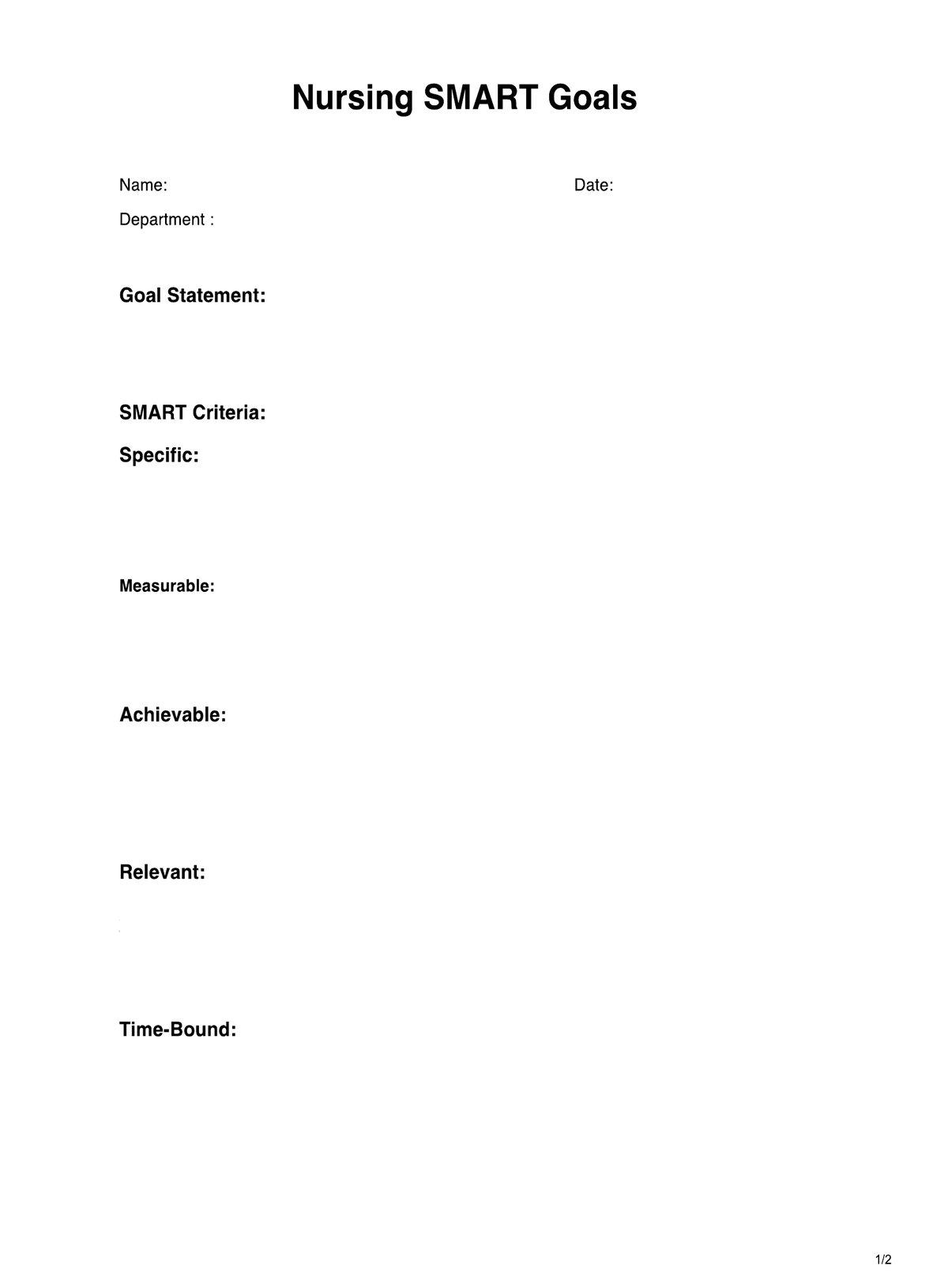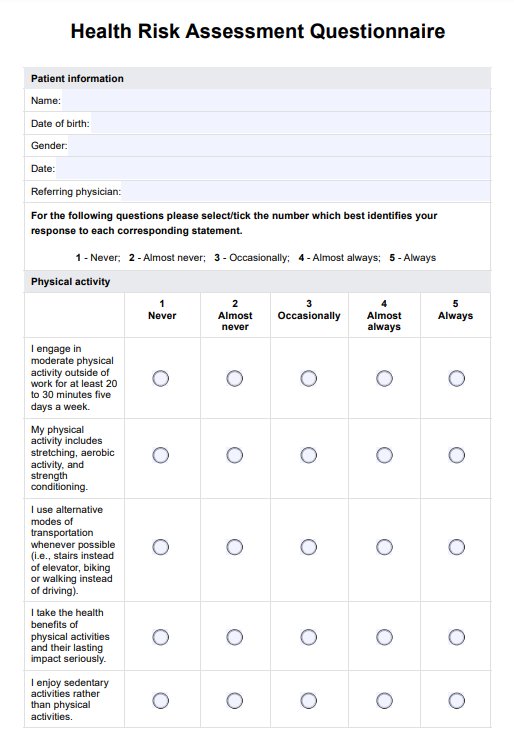Gastric Emptying
Explore the Gastric Emptying Test, a diagnostic tool for gastrointestinal disorders. Learn about its uses, procedures, and results.


What is a Gastric Emptying Test?
A Gastric Emptying Test, also known as a gastric emptying scan or study, is a medical procedure used to assess the rate at which food and liquids move from the stomach into the small intestine. This test is primarily conducted to diagnose and evaluate conditions related to delayed gastric emptying, known as gastroparesis. Gastroparesis is a disorder in which the stomach muscles do not function properly, leading to nausea, vomiting, abdominal pain, and bloating symptoms.
During a gastric emptying test, the patient is typically asked to consume a meal or drink that contains a small amount of radioactive material. This material can be easily tracked with a special scanner, allowing medical professionals to monitor food movement through the digestive system. Common foods used for this test include scrambled eggs or oatmeal mixed with a radioactive tracer.
After consumption, the patient lies down or sits beneath a scanner that records abdomen images at specific intervals. These images show the progress of the radioactive meal through the stomach and into the small intestine. By analyzing these images, doctors can determine if there are delays or abnormalities in the gastric emptying rate.
The test results help healthcare providers diagnose and manage conditions like gastroparesis. Treatment options may include dietary modifications, medication, or other therapies to improve gastric motility.
Gastric Emptying Template
Gastric Emptying Example
How Does it Work?
A Gastric Emptying Test is a diagnostic procedure used to assess the rate at which food leaves the stomach and enters the small intestine. Here's how the test works, broken down into critical steps:
1. Preparation
- To ensure an empty stomach, the patient should fast for a specified period, typically overnight.
- Inform the patient about the test, its purpose, and potential risks.
2. Administration of Radioactive Tracer
- A meal or drink is prepared with a small amount of radioactive material, usually Technetium-99m sulfur colloid or similar tracers. This radioactive material is safe and used solely for tracking purposes.
- The patient consumes the radioactive meal, often consisting of scrambled eggs, oatmeal, or a specific liquid.
3. Imaging Scans
- The patient is positioned under a gamma camera or scanner, which can detect and record the movement of the radioactive material.
- Images are captured at specific intervals, typically 1, 2, and 4 hours after ingestion.
- The gamma camera takes pictures of the abdomen, focusing on the stomach area.
4. Data Analysis
- Radiologists or gastroenterologists analyze the collected images to determine how the radioactive meal empties from the stomach into the small intestine.
- Delayed gastric emptying or abnormalities in the process are diagnosed based on these findings.
5. Results and Diagnosis
- The results diagnose conditions like gastroparesis, which may be characterized by delayed gastric emptying.
- These findings guide healthcare providers in planning appropriate treatment strategies, including dietary changes, medications, or other interventions.
When would you use this test?
The Gastric Emptying Test, often called a gastric emptying scan or study, is a valuable diagnostic tool used by medical practitioners, particularly gastroenterologists, to assess the function of the stomach and small intestine. Here are the critical situations when this test is appropriately used:
- Diagnosing Gastroparesis: The primary and most common indication for a Gastric Emptying Test is the diagnosis of gastroparesis. Gastroparesis is when the stomach muscles do not function properly, leading to delayed gastric emptying. Patients with chronic nausea, vomiting, abdominal pain, and early satiety may undergo this test to confirm the condition.
- Evaluating Unexplained Gastrointestinal Symptoms: When patients present with chronic and unexplained gastrointestinal symptoms, such as bloating, heartburn, or discomfort after eating, a Gastric Emptying Test can help identify if slow gastric emptying contributes to these issues.
- Monitoring Treatment Efficacy: For individuals already diagnosed with gastroparesis or other motility disorders, periodic Gastric Emptying Tests may be conducted to assess the effectiveness of treatment plans, including dietary modifications, medications, and lifestyle changes.
- Rule Out Other Gastrointestinal Disorders: In some cases, this test is used to rule out other gastrointestinal disorders that may mimic the symptoms of gastroparesis, ensuring that the correct diagnosis is made and appropriate treatment is initiated.
- Preoperative Evaluation: Before certain gastrointestinal surgeries, particularly those that may affect gastric motility, a Gastric Emptying Test may be conducted to assess baseline function and guide surgical planning.
- Research and Clinical Studies: Researchers and clinicians may use Gastric Emptying Tests in clinical trials or studies to better understand gastric motility, its variations, and its impact on various gastrointestinal conditions.
What do the Results Mean?
The results of a Gastric Emptying Test, which is crucial for diagnosing conditions like gastroparesis, provide valuable information about the rate at which food leaves the stomach and enters the small intestine. These results can be categorized into various scenarios, each with its implications:
Normal Gastric Emptying
- If the radioactive meal empties from the stomach within a typical timeframe (usually less than 10-20% of the meal remaining at 4 hours), it is considered a normal result.
- This suggests no significant delays in gastric emptying, and other causes for gastrointestinal symptoms should be explored.
Delayed Gastric Emptying
- Delayed gastric emptying is diagnosed when a significant portion of the meal remains in the stomach at the end of the test (usually more than 60-90% remaining at 4 hours).
- This result is a hallmark of gastroparesis, where the stomach muscles are impaired, leading to symptoms like nausea, vomiting, and abdominal pain.
Rapid Gastric Emptying
- In rare cases, the meal may empty too quickly, leading to gastrointestinal symptoms.
- Rapid gastric emptying may be associated with conditions like dumping syndrome, often related to specific surgeries.
Intermediate or Mixed Patterns
- Sometimes, results may show intermediate or mixed patterns, where different meal portions empty at varying rates.
- This may indicate a more complex motility disorder and require further evaluation and testing to determine the cause.
Correlation with Symptoms
Interpreting the results in the context of the patient's symptoms is essential. A normal test in a symptomatic patient may suggest a different underlying cause.
Research & Evidence
The Gastric Emptying Test, used to evaluate the emptying of food from the stomach into the small intestine, has a history dating back several decades and is supported by research and clinical evidence.
The concept of studying gastric emptying has been around for many years. Early methods involved ingesting a solid or liquid meal and using radiography to track its progress through the digestive system.
The use of radioactive tracers for this purpose began in the mid-20th century, and this approach became more standardized and less invasive over time.
Clinical studies and research have been instrumental in refining the Gastric Emptying Test. Here are some key aspects:
- Diagnostic Validity: Numerous studies have demonstrated the test's ability to diagnose gastroparesis and other gastric motility disorders accurately. It has provided essential diagnostic information for healthcare practitioners.
- Treatment Guidance: The test helps determine appropriate treatment strategies. For example, research has shown that dietary modifications and medications can improve gastric emptying rates, reducing symptoms and enhancing patient outcomes.
- Patient Management: Research has highlighted the value of Gastric Emptying Tests in monitoring treatment efficacy and disease progression, allowing for timely adjustments in patient management.
- Comparative Studies: Studies have compared different meal types and imaging techniques, contributing to the standardization of testing protocols and enhancing the reliability of results.
- Emerging Technologies: Research continues to explore and develop innovative technologies for assessing gastric emptying, such as magnetic resonance imaging (MRI) or breath tests. These advancements aim to improve the test's accuracy and patient experience.
References
- Banks, K. P. (2023, April 13). Gastric emptying scan. StatPearls - NCBI Bookshelf. https://www.ncbi.nlm.nih.gov/books/NBK531503/
- Children's Nebraska. (2020, March 3). What to Know About Your Child??s Gastric Emptying Test - Children's Nebraska. Children??s Nebraska. https://www.childrensnebraska.org/department/gastroenterology-hepatology-and-nutrition/pediatric-gastroenterology-patient-education/gastric-emptying-test/
- Farrell, M. B. (2019). Gastric emptying scintigraphy. Journal of Nuclear Medicine Technology, 47(2), 111??119. https://doi.org/10.2967/jnmt.117.227892
- Hayes, K., RN. (2022). Gastric emptying study: Test prep, purpose, results. Verywell Health. https://www.verywellhealth.com/gastric-emptying-scan-procedure-4587997
- Heitz, D. (2018, September 1). Gastric emptying scan. Healthline. https://www.healthline.com/health/gastric-emptying-scan
- Marks, J. W., MD. (2020, August 14). Gastric emptying Study results, preparation & side effects. MedicineNet. https://www.medicinenet.com/gastric_emptying_study/article.htm
- Patients & Families | UW Health. (n.d.). https://patient.uwhealth.org/healthfacts/7870
Commonly asked questions
Gastroenterologists or healthcare providers typically request Gastric Emptying Tests for patients exhibiting symptoms like chronic nausea, vomiting, abdominal pain, or early satiety, which could indicate gastric motility issues.
During a Gastric Emptying Test, a patient consumes a meal or drink with a radioactive tracer. Images are taken at specific intervals using a gamma camera to monitor the movement of the meal from the stomach into the small intestine, providing insights into gastric emptying.
A Gastric Emptying Test typically takes about 4 hours, with images taken at intervals throughout this period to track the movement of the meal through the digestive system.


